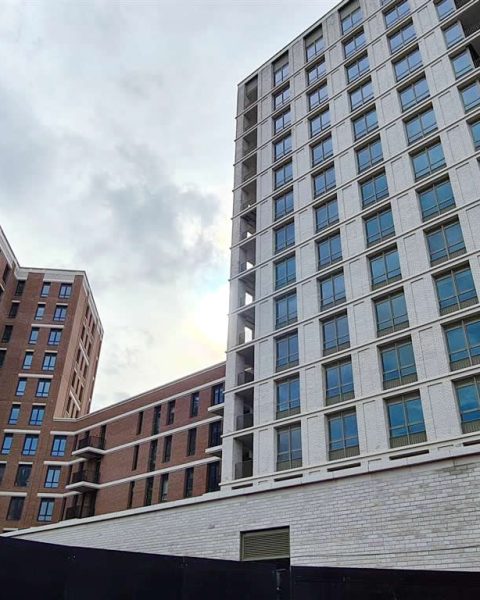Wandsworth Council has unveiled new plans for housing presented as ‘ambitious’ even though they would deliver hundreds fewer homes a year than previous targets.
Council leader Simon Hogg announced a new plan in August that will deliver 14,000 new dwellings over the next decade in the borough of Wandsworth.
Unveiling the plans, Hogg said:
“It was great to talk to local businesses about how our plan will put people first and unlock inclusive growth that works for everyone in Wandsworth.”
Echoing the Labour government’s ‘Growth, Growth, Growth’ mantra, the Wandsworth Growth Plan (pdf) will be driven by a new Clapham Junction Growth Corridor, stretching from Battersea and Nine Elms through Clapham Junction and on to Wandsworth Town.
As part of this vision, the Council has created a dedicated team to develop a Clapham Junction Masterplan. A design team led by Weston Williamson + Partners (WW+P) has been appointed to propose improvements to north–south connections across the station. Strategic oversight sits with a project board chaired by Network Rail, alongside the Council, representatives of the Shop Stop mall and a Clapham Junction Community Panel, said to represent the local community.
Read also: Clapham Junction Masterplan: Secret Panel, Ignored Expertise and Recycled Ideas
The document refers to the “potential for an additional 10,000 homes” over the next decade, and in more detail identifies capacity for 8,400 homes in Nine Elms, 3,000 in the Winstanley and York Road and Clapham Junction area, and 3,000 in Wandsworth Town — a total of 14,400.
However, these new targets appear at odds with a series of previous numbers established as recently as 2023. Chiefly – under the London Plan in 2019 – the council presented a revised target of 19,500 homes to be built over the next decade, at a yearly rate of 1950. August’s new scheme, described as “clear”, “ambitious“, and “forward-thinking”, would instead crunch the yearly rate of homes built to 1400, hundreds less per year than had been previously targeted.
Furthermore, the breakdown of the 14,400 “additional” homes — with 3,000 in Clapham Junction and another 3,000 in Wandsworth Town — largely mirrors schemes already proposed or approved but not yet built.
In the Winstanley and York Road estates, for instance, the Council’s plan still envisages about 2,500 new homes, of which fewer than 200 have been completed. In Wandsworth Town, nearly 2,000 units have been approved since 2017: the Homebase/Swandon Lane site (385 in 2017, later increased to 462 in 2020); the B&Q site (517 in 2018, later increased to 632 in 2021); the Gas Works site (620, approved in 2025); and, most recently, 2 Armoury Way (434 student rooms).
And that is without mentioning the government plan presented in September 2024, by the then Deputy Prime Minister and Housing Secretary Angela Rayner. She confirmed that London should aim for 81,000 new homes per year — more than double the current target of 37,000. Though lower than the previous benchmark of 100,000, this remains far above the city’s recent performance: only 35,000 homes were completed last year, compared with the 53,000 projected in the London Plan.
While boroughs vary widely, the figure implies an average of around 2,500 new homes per borough per year, a level barely reached by Wandsworth even during the booming construction period in Nine Elms.
The golden age of construction in Wandsworth might have passed
Yet the wider construction environment has shifted sharply.
Research commissioned by Wandsworth Council in 2024 outlined that the borough had the capacity to build 26,315 homes over the next 15 years, and that the council believed in aiming to build to this capacity, as the housing crisis in London deepens and construction rates plummet nation-wide. According to the same research, over 14,000 of these homes need to be affordable to stave off the growing housing crisis.
In that scenario, the borough would build more than 1,700 homes a year, with around half classified as affordable. That is close to what Wandsworth delivered between 2012/13 and 2021/22, when it saw a net total of 16,671 homes built — roughly 1,667 per year.
Read our article: Wandsworth refusal on Springfield overturned by the Deputy Mayor of London
Housing delivery targets in previous years were strongly exceeded, according to the Authority Monitoring Report (Housing Committee report September 2023), placing Wandsworth Council in a very different position to the past.
But with the recent changes to delivery plans for the borough, it appears that previous targets for home-building in the borough have already proven overly optimistic. The recommendations of the Research document might prove increasingly difficult to implement, though, as the future of affordable housing in London is in jeopardy.
Cutting the affordability target might cause new difficulties for Wandsworth
The Ministry of Housing, Communities and Local Government, in agreement with the Mayor of London, announced two weeks ago that the required level of affordable housing in London would be slashed from 35% to 20%.
This new quota aims to speed up housebuilding through streamlined planning and financial incentives. Meanwhile, the Labour government’s plans to build 1.5 million homes in the UK were reaffirmed after the reshuffle earlier this Autumn, with new Housing Minister Steve Reed insisting that the target would be met at all costs. This pressure has already been linked with the slash to affordable housing targets.
Amid competing local ambitions and citywide (and national) restructuring, developers in London have in the last few weeks claimed that affordable housing requirements are driving away investors. In Peckham, the 877-dwelling Aylesbury Estate development cut its number of units designated as affordable to 8%, with the developer hitting back this week at a public inquiry’s criticism. Berkeley described the 35% affordable housing target as “simply unattainable.”
However, with £5.5. million spent daily on homelessness and temporary accommodation by London councils, and more and more families spending years waiting for social or affordable homes to become available, there are no easy choices for local authorities.
Housing Minister Steve Reed’s legacy as former leader of Lambeth Council is particularly controversial on that record. Lambeth Council is suffering one of the worst housing crises in the country. Poor maintenance and lack of investment has led to flooding, sewage leaks, asbestos, and an array of other hardships over the last few years, requiring billions in investment and burdened with the second-highest number of housing complaints nationwide.
With Reed now setting national policy, it leaves Wandsworth in a difficult position —Wandsworth Council has frequently touted its higher-than-average affordable housing targets, striving for 50% of all homes built in the Labour-run borough to be affordable.
Councillor Matthew Corner, housing spokesman for the Wandsworth Conservatives, described current targets as “unrealistic”. He said:
“Wandsworth Labour should join with the Mayor in abandoning this failed approach and instead consider ways to incentivise the building of homes our borough needs.”
Tensions between Wandsworth Council and private developers have already been inflamed this year as Taylor Wimpey walked away from construction of the 2550-home regeneration of the historic Winstanley Estate in Clapham Junction, with their exit costing the council over £24 million.
Since then, Wandsworth Council has announced plans to regenerate the estate themselves, providing a provisional 10-year plan in September, though without clarifying dates or a clear timeframe for construction to begin. In the meantime, residents of the estate have waited 15 years for regeneration to proceed.
Council leader Simon Hogg, meanwhile, declined to comment.


















